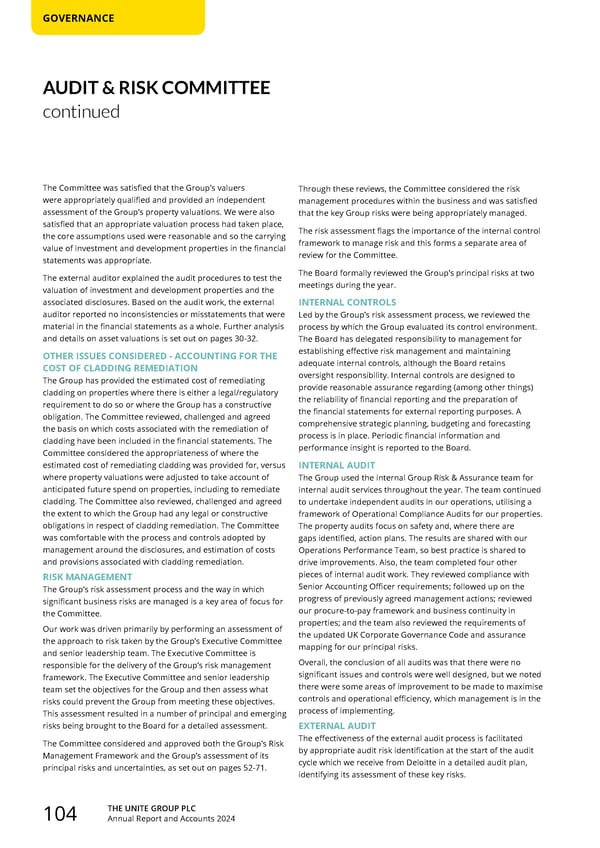THE UNITE GROUP PLC Annual Report and Accounts 2024 104 The Committee was satisfied that the Group’s valuers were appropriately qualified and provided an independent assessment of the Group’s property valuations. We were also satisfied that an appropriate valuation process had taken place, the core assumptions used were reasonable and so the carrying value of investment and development properties in the financial statements was appropriate. The external auditor explained the audit procedures to test the valuation of investment and development properties and the associated disclosures. Based on the audit work, the external auditor reported no inconsistencies or misstatements that were material in the financial statements as a whole. Further analysis and details on asset valuations is set out on pages 30-32. OTHER ISSUES CONSIDERED - ACCOUNTING FOR THE COST OF CLADDING REMEDIATION The Group has provided the estimated cost of remediating cladding on properties where there is either a legal/regulatory requirement to do so or where the Group has a constructive obligation. The Committee reviewed, challenged and agreed the basis on which costs associated with the remediation of cladding have been included in the financial statements. The Committee considered the appropriateness of where the estimated cost of remediating cladding was provided for, versus where property valuations were adjusted to take account of anticipated future spend on properties, including to remediate cladding. The Committee also reviewed, challenged and agreed the extent to which the Group had any legal or constructive obligations in respect of cladding remediation. The Committee was comfortable with the process and controls adopted by management around the disclosures, and estimation of costs and provisions associated with cladding remediation. RISK MANAGEMENT The Group’s risk assessment process and the way in which significant business risks are managed is a key area of focus for the Committee. Our work was driven primarily by performing an assessment of the approach to risk taken by the Group’s Executive Committee and senior leadership team. The Executive Committee is responsible for the delivery of the Group’s risk management framework. The Executive Committee and senior leadership team set the objectives for the Group and then assess what risks could prevent the Group from meeting these objectives. This assessment resulted in a number of principal and emerging risks being brought to the Board for a detailed assessment. The Committee considered and approved both the Group’s Risk Management Framework and the Group’s assessment of its principal risks and uncertainties, as set out on pages 52-71. Through these reviews, the Committee considered the risk management procedures within the business and was satisfied that the key Group risks were being appropriately managed. The risk assessment flags the importance of the internal control framework to manage risk and this forms a separate area of review for the Committee. The Board formally reviewed the Group’s principal risks at two meetings during the year. INTERNAL CONTROLS Led by the Group’s risk assessment process, we reviewed the process by which the Group evaluated its control environment. The Board has delegated responsibility to management for establishing effective risk management and maintaining adequate internal controls, although the Board retains oversight responsibility. Internal controls are designed to provide reasonable assurance regarding (among other things) the reliability of financial reporting and the preparation of the financial statements for external reporting purposes. A comprehensive strategic planning, budgeting and forecasting process is in place. Periodic financial information and performance insight is reported to the Board. INTERNAL AUDIT The Group used the internal Group Risk & Assurance team for internal audit services throughout the year. The team continued to undertake independent audits in our operations, utilising a framework of Operational Compliance Audits for our properties. The property audits focus on safety and, where there are gaps identified, action plans. The results are shared with our Operations Performance Team, so best practice is shared to drive improvements. Also, the team completed four other pieces of internal audit work. They reviewed compliance with Senior Accounting Officer requirements; followed up on the progress of previously agreed management actions; reviewed our procure-to-pay framework and business continuity in properties; and the team also reviewed the requirements of the updated UK Corporate Governance Code and assurance mapping for our principal risks. Overall, the conclusion of all audits was that there were no significant issues and controls were well designed, but we noted there were some areas of improvement to be made to maximise controls and operational efficiency, which management is in the process of implementing. EXTERNAL AUDIT The effectiveness of the external audit process is facilitated by appropriate audit risk identification at the start of the audit cycle which we receive from Deloitte in a detailed audit plan, identifying its assessment of these key risks. AUDIT & RISK COMMITTEE continued GOVERNANCE
 Home for Success: Unite Students Annual Report 2024 Page 105 Page 107
Home for Success: Unite Students Annual Report 2024 Page 105 Page 107